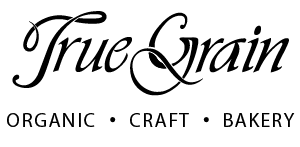
History of Wheat
Wheat is the main staple of the human diet in many parts of the world. People often ask us about the different types of ancient grains we use and how they differ from modern wheat.
The earliest type of wheat is called Einkorn. It has 14 chromosomes compared to modern wheat’s 42. Einkorn mills nicely, almost like white flour. It’s easily digestible by many who suffer from (non-celiac) wheat allergies. The downside of Einkorn is that it’s very expensive, with lower yields poorly per acre vs. modern wheat or even Spelt. The economic upside for the local economy is that it’s grown organically in BC.
The second earliest type of wheat is Emmer. Emmer has 28 chromosomes. Emmer (also called Faro) and Einkorn were the first agricultural crops, which enabled human evolution from that of roaming nomad to farmer. When the Bible references “the staff of life” and “our daily bread,” it is Emmer being praised. Emmer tends to be grittier than Einkorn or modern wheat and is more difficult to bake with, even when sifted. On the upside, Emmer is also more easily digestible than modern wheat for many people. Organic Emmer is also grown in BC.
The most popular of the ancient grains is Spelt. Spelt has 42 chromosomes and is a hulled wheat, the removal of which requires an extra step in the cleaning process. Spelt was ignored for many years as farmers focused on un-hulled wheat varieties to drive down costs and feed growing populations. Spelt has a unique, nutty flavour and is wonderful to bake with. We source the bulk of our organic Spelt from the north Okanagan. Spelt is also high in protein, as well as phosphorous, zinc and iron. At True Grain, our Light Spelt is a yeast leavened, 100 % BC organic Spelt loaf is kid friendly and great for toast and sandwiches. Our Wholegrain Spelt is a heavy, high-fibre sourdough with an organic rye starter, perfect for open-faced European style sandwiches.
The next ancient wheat is called Khorasan, often called Kamut. In 1949 a Montana farmer was given some kernels said to be taken from an Egyptian tomb. They grew and eventually he eventually branded the wheat Kamut. The Khorasan grain is twice the size of modern wheat and is known for its rich, nutty texture. It’s also high in protein as well as vitamins like Niacin and minerals such as Manganese. Our organic BC Wholegrain Khorasan loaf is a popular choice for those following a wholefood, plant-based diet.

Then we have Rye, a close relative to barley and a European staple grain for centuries. It has a lower gluten content than modern wheat and contains a higher proportion of soluble fiber.
Fast forward to today. Ancient grains are making a comeback, and we’re lucky that all these varieties are organically grown right here in BC. However, 99% of the wheat used in Canada is still a modern variety. This brings us to how wheat farming and processing and how it’s changed in four key areas:
- milling
- breeding
- enhancement
- homogeneity
Milling – Once upon a time, every community had a stone mill, where the harvest was freshly ground and used in the community. It was rudimentary technology, so the resulting flour, even when sifted, still maintained a good portion of the outer kernel (bran). Early communities benefitted from this process because the bran contains most of the nutrients in the kernel and is a high source of fibre. Today, milling is done centrally in large volumes using highly efficient technology. The processing is so effective that the resulting flour is essentially pure carbohydrate and void of any of the bran. The body treats it like a sugar.
Breeding – It’s estimated there are over 25,000 varieties of wheat that have been developed in the last 35 years. The breeding is done to maximize the good traits and minimize the less desirable ones. Over time, human ingenuity was able to overcome many obstacles: Grows too tall? Dwarf it. Season is too long? Shorten it. Doesn’t carry enough wheat berries per plant? Increase it. The downside is some research suggests that up to 5% of proteins are newly created in hybridization of grain each time. (i.e. the protein doesn’t exist in either parent). When that happens enough times, the protein structure (gluten) of first wheat going in is different from the newly created protein structure (gluten) of 25,000th one coming out. Could this help to explain why more people seem to have difficulty digesting wheat?

Enhancement. Canadian Law has specific rules for “white flour”. It must be enriched with vitamins and minerals such as iron, thiamine and riboflavin. In addition, the law also allows many chemicals to be added. These agents serve one of 3 purposes; to bleach, to preserve or to improve baking properties. None of the chemicals such as chlorine, benzoyl peroxide, azidobicarbonate or l-cysteine or a host of others need to be declared on the label. Unless it specifically says unbleached and untreated, it likely has been. How is it acceptable that our food labelling laws permit this?
Homogeneity – In 1935, The Canadian Wheat Board was established. It was implemented to bundle all grain producers in the prairies and guarantee a market and market price for grain farmers. This was great economically as Canada could reach export markets very effectively and it was good for the farmer who was guaranteed a customer at a good price. The downside was lack of biodiversity and consumer choice. If we employed the same strategy to the wine business, you could enjoy a merlot, a merlot or a merlot.
At True Grain we believe that the recent renewed interest in ancient wheat varieties is more than a passing fad. Each delivers a unique flavour experience and are still niche enough that they can be processed and brought to value by small producers. We’re proud to be part of the resurgence back to real food, grown and prepared with care. Interested in baking with ancient grains? Download our colour-coded grain guide to get inspired before heading to the mill shelf to choose your flour.

Leave a comment